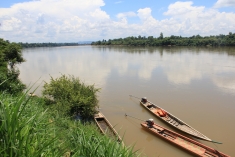Mekong Dams Put Cambodian Food Security At Risk
Originally published in The Bangkok Post
Cambodia's per capita consumption of inland fish is among the highest in the world and its people depend on fish for nearly three-quarters of their protein intake. But information released by the Cambodian Fisheries Administration (FiA) may be a game-changer for the future of the Mekong River.
A report financed by the Danish development agency Danida, Oxfam and WWF shows how the combined effects of mainstream dams in Cambodia and population growth could reduce the country's consumption of fish from 49kg to as little as 22kg per person per year by 2030 that is an astounding 55% reduction. The report makes clear that dams are a matter of national security rather than simply an environmental concern.Cambodia's per capita consumption of inland fish is among the highest in the world and its people depend on fish for nearly three-quarters of their protein intake. But information released by the Cambodian Fisheries Administration (FiA) may be a game-changer for the future of the Mekong River.
Bad news about the impacts of dams on food security and health in the Mekong region is not new: several reports have documented how dams result in reduced fish yields by fragmenting and changing the hydrology of critical habitat.
But the Cambodian FiA report is different. First, it used a nationwide survey of food consumption in Cambodia the first of its kind designed by the National Institute for Statistics. The survey sampled 1,200 households to estimate fish consumption and the role of fish in people's diets.
Second, it used high-resolution hydrological models to estimate future fish yields and how different fish species respond to habitat fragmentation and hydrological modification.
Third, it measured trends in fish supply from aquaculture, the use of small, low-value fish for aquaculture feed, and fishery imports and exports.
The results are clear: hydropower development on the Mekong River's mainstream and population growth will come at a major cost to Cambodia's food security, nutrition and health. Given what's at stake, the region's leaders and the people who depend on the river must work together to confront this dangerous nexus of dams, fish and food security before it's too late.
Hydropower can be an essential component of power planning, if done wisely. Yet, some of the most destructive dams in the region have been proposed for development, posing significant risks ahead for Cambodia's inland fisheries as well as to the livelihoods and health of millions of people who depend on the Mekong River's fish should these projects continue to advance.
Preparatory work is already underway on the Don Sahong Dam on the Mekong River's mainstream, even though Laos has yet to officially seek agreement from neighbouring countries as required by the 1995 Mekong Agreement for projects that create year-round diversions and impacts to the basin. This project has the potential to significantly alter Cambodia's fisheries, as it would create an impassable barrier for dry-season fish migration.
Meanwhile, land downstream in Cambodia is being cleared for the construction of the Lower Sesan 2 Dam at the confluence of the Sesan and Srepok rivers. A 2012 study has predicted that this dam alone could reduce fish yield by as much as 9% basinwide. Donors to the Mekong River Commission have responded by calling on Cambodia to voluntarily seek regional agreement for the project rather than proceed unilaterally.
Alternatives for both of these projects, which would generate similar amounts of power with fewer impacts, have been presented and are in need of greater consideration.
The region only needs to look to Vietnam to learn important lessons about policy aimed at balancing energy needs with sustainable development. A dam building boom that took place in Vietnam over the past decade has yielded troubling results.
Since 2011, the Song Thanh Dam has triggered a series of seismic tremors that devastated villages and terrified their inhabitants. Since 2012, the Dak Mi 4 Dam has cut off the water supply to Da Nang, Vietnam's third largest city. Several dams have since collapsed. These cases, along with other dam-related disasters, have led the government to cancel dozens of projects and for the National Assembly to recently declare that hydropower and its impacts will be a top priority issue in 2014.
Vietnam's deputy prime minister has since called upon the Mekong countries to ratify the 1997 UN Watercourse Convention. Unlike the 1995 Mekong Agreement, which failed to address the concerns of Vietnam and Cambodia over the impacts of Laos' Xayaburi Dam, this convention provides a binding mechanism to prevent dams from being built that could have large-scale transboundary impacts.
With the Mekong's fish and people at stake, as evidenced by the Cambodian FiA report, complex and life-changing decisions over whether to develop these projects, or instead explore more sustainable energy options, will need to be made. Let's hope science trumps politics.



